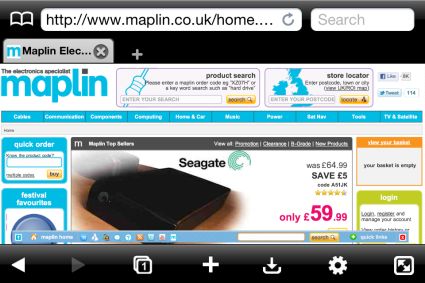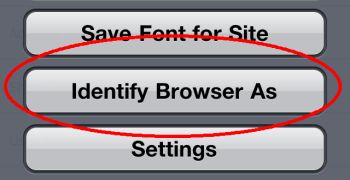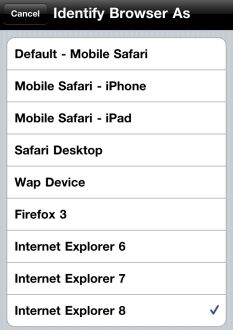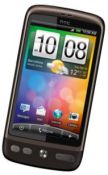Disabling the mobile version of a website on an iPhone
Got a smartphone? Don’t you just hate it when you visit a website, only to be served with a “mobile optimised” version of that site.
Now, we know those sites are in place for our benefit… they load faster, and typically exclude Flash, ads, and other junk that slows down the mobile experience… but now and again, we need to get to the other stuff on the site, and sometimes it’s hard.
Today, the problem with mobile versions of a website caused me a real problem. I used my iPhone to visit the Maplin website at www.maplin.co.uk – The browser redirected me to mobile.maplin.co.uk – which was down. Here’s a screen capture of what the Maplin site has been doing all day today:

Maplin's Mobile Website, broken on iPhone
The problem was only with the mobile website – the desktop version was fine, but there was no way to get the iPhone to do to the Desktop version. We found a way though – it look a couple of minutes, and this was what we were able to get on our iPhone 4:

Desktop site working on the iPhone
So, how did we manage to get our iPhone to start showing the desktop version of websites? Well, sadly there’s no magic setting on the iPhone to do this? Well…
How to make an iPhone avoid a Mobile website
To be able to fool a website into not giving us the optimised version, what we ended up doing was to install a different web browser. A browser that can “pretend” it’s not a mobile phone browser.
After some research, we found the Atomic Web Browser for iPhone – the free version doesn’t do the magic we needed, but the 69 pence browser app does.
If you’re sick of mobile versions of websites, pay your £0.69 and download the app in iTunes (link), then do the following:
- Open the Atomic Web app
- Press the Settings button (looks like a cog)
- Select “Identify Browser As”

Atomic Web Browser Settings Screen
From the next screen, you have the option to change what’s known as the “UA Prof” (or User Agent Profile String). This is the setting in a web browser that identifies the browser to websites. The iPhone browser says “Hello, I’m an iPhone”. The setting in the Atomic Web browser allows you to get the browser to pretend to be something it’s not. Here’s what it can identify as:

Atomic Web Browser - UAProf Screen
So there you go. We set our browser to be an Internet Explorer browser, and the Maplin site was happy to believe we weren’t an iPhone and let us in.
The solution worked for us. We hope it’ll work for you too!

 Great news for mobile phone users travelling to Europe. As of the 1st of July 2011, it’ll be cheaper to roam.
Great news for mobile phone users travelling to Europe. As of the 1st of July 2011, it’ll be cheaper to roam.